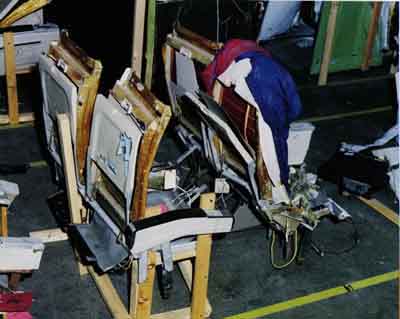
| |
Row 17 and 18 seats from the reconstructed wreckage of TWA Flight 800.
Note the missing fabric and foam material above tray tables.
|
Red Residue Stripped from Seats
The suspicious red residue within the wreckage of TWA Flight 800,
alleged to be evidence of an explosive material, has been reportedly
removed from all seats upon which it once covered. According
to James Sanders, all fabric containing the red residue has been
removed from the seats in rows 17-19 which are being stored at
FBI headquarters in Long Island, NY. Mr. Sanders recently visited
the headquarters where he noticed the red residue absent from
every seat.
James Sanders obtained test results from the residue at West Coast
Analytical Services (WCAS) in Santa Fe Springs, CA on January
31, 1997. In March of 1997, the residue made headlines nationwide
after the Press Enterprise of Riverside California published the
WCAS results which showed high concentrations of elements consistent
with missile fuel and pyrotechnics. Public pressure prompted the
National Transportation Safety Board (NTSB) to independently identify
the source of the red residue.
The NTSB contracted the NASA Material Science Division to compare
seating material from rows 17-19 with a known seat adhesive (3M
1357 Scotch Grip Adhesive). A NASA report concluded some of the
seating material to be consistent with the named adhesive. This
report was used by NTSB officials to claim that the red residue was
glue. However, the NTSB did not test the samples represented in
the Press Enterprise article. Separate samples were lifted from
the wreckage, and no attempt was made to determine by chemical
analysis if these samples were consistent with those tested at
WCAS.
Sanders acquired the samples from lead TWA investigator Terrel
Stacey, who removed the residue from seats within the reconstruction
at the Calverton Hangar in Long Island. Stacey contends the residue
he removed represented a small fraction (reported to cover a few
postage stamps in size) of the total. Samples sent to NASA covered
approximately 170 square centimeters, or about the size of a business
size envelope. All remaining residue and fabric, allegedly removed
from each seat in the section, has not been represented by any
publicly released report or statement by the FBI or NTSB.
|